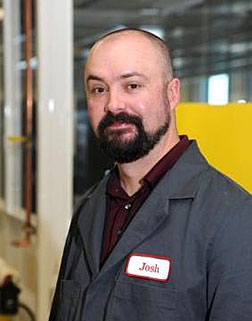- Number 408 |
- March 3, 2014
Following through: Mechanical engineer leaves links for nuclear research

Idaho mechanical engineer Josh Daw is
devising methods for observing material
properties during irradiation.
Joshua Daw enrolled in an undergraduate engineering program with hopes of growing up to be a golf club designer. He had been spending his days on the green, and wasn't quite ready to leave. Today, however, his career is going places — though not in the direction he first thought.
As is a Ph.D. student at the University of Idaho, he is completing his doctoral thesis work at DOE's Idaho National Laboratory, in the High Temperature Test Laboratory (HTTL). A serendipitous DOE-funded, UI and INL research opportunity at the HTTL led him to high-temperature instrumentation work.
Daw earned first prize in the Fuel Cycle Research Innovations competition for his paper, “Hot Wire Needle Probe for In-Reactor Thermal Conductivity Measurement” (IEEE Sensors, August, 2012). He accepted the award at the American Nuclear Society meeting in Washington, D.C., in November. Last week he accepted INL's Laboratory Director's Award for Exceptional Engineering Achievement.
Daw's winning work, completed with INL researchers Joy Rempe and Darrell Knudson, addresses the question of how to measure thermal conductivity during irradiation. Thermal conductivity — which measures how materials conduct heat — is considered “one of the most important physical characteristics of fuels,” Daw explains. In most materials, it is measured by evaluating samples after reactor irradiation. This “cook and look” approach, as Rempe calls it, is an invasive and expensive process.
Previous methods for taking these measurements during irradiation required several assumptions that limit accuracy. Working at the HTTL, this team developed a method to make such measurements with a hot wire needle probe. High quality thermophysical property data collected using an in-pile method such as Daw’s could lead to better simulation design codes and improvements to the next generation of nuclear reactors.
“It is always nice to be recognized for the work we do,” Daw said. Daw expects to complete his Ph.D. program in May. As for post-doc plans, Daw — who still plays golf every chance he gets — jokes, “There are a few more degrees I'm interested in, so who knows?”Submitted by DOE's Idaho National Laboratory
